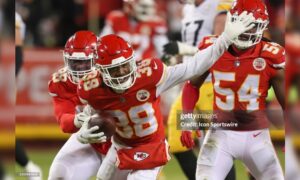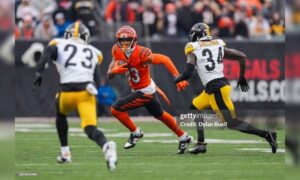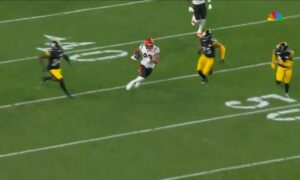A lot has been made about the Sunday low hit by Pittsburgh Steelers safety Mike Mitchell on Kansas City Chiefs quarterback Alex Smith. Several have since called Mitchell’s hit deliberate and on Monday the safety defended his actions.
“I felt myself tripping. I felt myself being pushed. I felt myself losing balance,” Mitchell said, according to the Pittsburgh Tribune-Review. “I was aware of the rule. If you watch the tape, I’m even trying to turn my body while I am falling. Alex is backpedaling into me. I wasn’t even going in the direction of Alex. He actually is throwing and fading away. It’s a lot of things that go into the play that make it an accident that you don’t want to see — but that’s exactly what it is.”
Now that the all-22 tape of Sunday’s game between the Steelers and Chiefs has been released, I have been able to zoom in on Mitchell’s feet as he’s chasing Smith from behind. I have slowed down the tape and I think you can clearly see that Mitchell gets his foot stepped on by Steelers outside linebacker Anthony Chickillo and this in turn causes him to fall forward.
Personally, I think this exonerates Mitchell of any wrong doing on this play and I don’t think he should be fined for hitting Smith low. If he is fined, he should appeal.
Now, while Mitchell might not ultimately be fined for that low hit on Smith, he might be fined for his hit on Chiefs running back Charcandrick West with two minutes left in the first half. You can see that hit below along with the rule that Mitchell may have violated.
ARTICLE 7. PLAYERS IN A DEFENSELESS POSTURE
It is a foul if a player initiates unnecessary contact against a player who is in a defenseless posture.
Players in a defenseless posture are:
A player in the act of or just after throwing a pass (passing posture)
A receiver running a pass route when the defender approaches from the side or behind. If the receiver becomes a blocker or assumes a blocking posture, he is no longer a defenseless player.
A receiver attempting to catch a pass who has not had time to clearly become a runner. If the player is capable of avoiding or warding off the impending contact of an opponent, he is no longer a defenseless player
The intended receiver of a pass in the action during and immediately following an interception or potential interception. If the player is capable of avoiding or warding off the impending contact of an opponent, he is no longer a defenseless player.
Note: Violations of this provision will be enforced after the interception, and the intercepting team will maintain possession.
A runner already in the grasp of a tackler and whose forward progress has been stopped
A kickoff or punt returner attempting to field a kick in the air
A player on the ground
A kicker/punter during the kick or during the return (Also see Article 6(h) for additional restrictions against a kicker/punter)
A quarterback at any time after a change of possession (Also see Article 9(f) for additional restrictions against a quarterback after a change of possession)
A player who receives a “blindside” block when the path of the offensive blocker is toward or parallel to his own end line.
A player who is protected from an illegal crackback block (see Article 2)
The offensive player who attempts a snap during a Field Goal attempt or a Try Kick
Prohibited contact against a player who is in a defenseless posture is:
forcibly hitting the defenseless player’s head or neck area with the helmet, facemask, forearm, or shoulder, even if the initial contact is lower than the player’s neck, and regardless of whether the defensive player also uses his arms to tackle the defenseless player by encircling or grasping him
lowering the head and making forcible contact with the crown or ”hairline” parts of the helmet against any part of the defenseless player’s body
illegally launching into a defenseless opponent. It is an illegal launch if a player (i) leaves both feet prior to contact to spring forward and upward into his opponent, and (ii) uses any part of his helmet to initiate forcible contact against any part of his opponent’s body. (This does not apply to contact against a runner, unless the runner is still considered to be a defenseless player, as defined in Article 7.)
Note 1: The provisions of (b) do not prohibit incidental contact by the mask or helmet in the course of a conventional tackle or block on an opponent.
Note 2: A player who initiates contact against a defenseless opponent is responsible for avoiding an illegal act. This includes illegal contact that may occur during the process of attempting to dislodge the ball from an opponent. A standard of strict liability applies for any contact against a defenseless opponent, even if the opponent is an airborne player who is returning to the ground or whose body position is otherwise in motion, and irrespective of any acts by the defenseless opponent, such as ducking his head or curling up his body in anticipation of contact.
Penalty: For unnecessary roughness: Loss of 15 yards and an automatic first down. The player may be disqualified if the action is judged by the official(s) to be flagrant.








